 Apr 23, 2021
Persona
Apr 23, 2021
Persona
In higher education, SEO can often get pushed aside or thought of as a “set it and forget it” strategy. However, with Google changing its algorithm constantly and new features being added to search results regularly, colleges and universities need to think about SEO on an ongoing basis in order to stay visible.
One of the biggest SEO trends where higher education currently falls behind is special SERP (Search Engine Results Page) features. So few schools are actually optimizing their sites for these and are losing out on valuable Google real estate as a result.
While it’s good to show up in the regular organic listing in the SERP, it’s even better to take up an entire box or section that better grabs the user’s attention. However, there are many special SERP features that simply aren’t relevant for higher education institutions. Here, we’ve outlined the top special SERP features for colleges and universities and how to optimize for them.
For each type of special SERP feature, there are specific strategies you can put into place to increase your chances for visibility. With that being said, there are also best practices you should follow across the board to optimize your site for all types of special SERP features and even regular organic listings. Most notably, you want to ensure that each web page has a unique title tag and meta description that targets specific keywords and adheres to Google’s best practices for length and formatting. You can read more about other top SEO content best practices here. Furthermore, always check Google Search Console to make sure your content isn’t being flagged for any mobile usability issues, which can affect your ability to show up for special SERP features.
Featured rich snippets
When you Google something and an answer appears right at the top of the results page, contained within a box, that’s called a featured rich snippet. Sometimes just a sentence or two appears in this box, while other times a bulleted or numbered list may appear. This is often called “position 0.” It’s important to note that a featured rich snippet doesn’t appear for every search. If you do appear in the rich snippet spot, you’ll also appear at the top of page 2 as a regular organic listing.
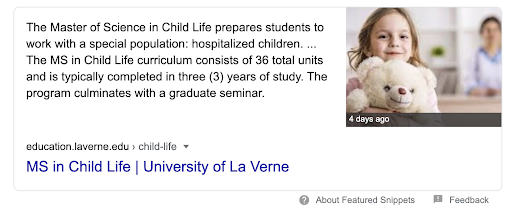
A rich snippet for a program page
How to optimize for featured rich snippets
Featured rich snippets often appear for question-based searches. Therefore, ensuring that your content’s header tags contain questions that are followed by answers puts you at a huge advantage. Rich snippets are often what get read aloud in voice search as well, so optimizing for them also means optimizing for voice search. These snippets are also often accompanied by an image, so ensuring that you have an image on the page that’s also optimized is key—the image should be compressed so as not to affect page speed. The file name should contain keywords, as should the title text and alt text for the image.
You can also use how-to schema markup for numbered lists that can appear in the featured rich snippet spot. For higher education, this could be utilized for application steps, for example.
Sitelinks
Sitelinks give users the opportunity to click through to different areas of your site—so instead of just appearing with one link, you can appear with several links, thus increasing CTR and improving user experience. Users don’t have to filter through one page and then navigate to tertiary pages—instead, they can navigate directly to those tertiary pages right from Google.
Sitelinks can appear in two different ways. For top navigation pages that appear in the SERP with sitelinks, you generally receive much more Google real estate. With pages deeper in the navigation that appear with sitelinks, such as child and tertiary pages, those links generally appear in just one line in smaller text below the result.
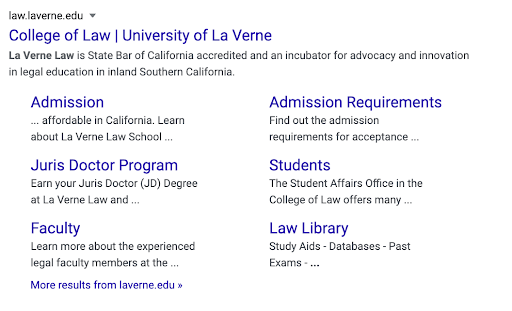
Sitelinks for a top navigation page

Sitelinks for a child page
How to optimize for sitelinks
In order to appear for sitelinks, your website needs to have a clear and intuitive information architecture, and content needs to be housed properly under the correct folders. Sitelinks reflect pages that are in the next folder deep from the main search result. Therefore, having secondary pages nestled in the correct folders with URL paths that reflect that is critical. What’s more, those pages must have strong title tags that adhere to Google’s best practices for length and formatting, as the title tags serve as the sitelink text.
You can also utilize schema markup to implement a sitelinks search box. This would allow users to search for content on your site in a separate search bar within the Google SERP. This feature mainly appears for home page results only.
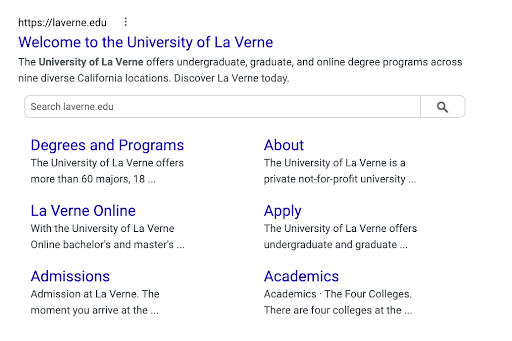
A sitelinks search bar can be seen above for University of La Verne
Google My Business (GMB) & Knowledge Panel
Google My Business
Google My Business is an essential component of any local SEO strategy. You’ve likely encountered GMB properties dozens of times before when searching for restaurants, stores, or coffee shops. Appearing on the right-hand side of the SERP on desktop and at the top of the SERP on mobile, these properties contain address, phone number, business hours, photos, reviews, and more and also contain buttons to the website, click to call, and directions (integrated with Google Maps). For higher education institutions, additional information can also be pulled into GMB properties.
GMB properties appear in several different formats in Google’s search engine results, including as a full property view, in the local pack, as college cards, and in the college pack. If you’re not appearing in these special SERP features for top queries, surely your competitors are. It’s imperative to ensure that your GMB property is optimized so that users searching for what your school offers can find you.
Google My Business properties are created for physical locations. You must have an address that USPS can deliver a piece of mail to in order to have a GMB property. Many universities have dozens of different GMB properties for different schools or colleges, departments, centers, and regional campus locations. For the most part, Google automatically creates these properties and it’s up to you to claim them. You do have the option to manually create a property if you have a unique address and a department/center for which you want to create a property, though properties you start from scratch are often slow to get traffic. It’s important to note that online schools often do not have GMB properties because they do not have physical addresses.
GMB properties for the main campus usually get IPEDS and College Board data automatically pulled into them by Google. This is not the case for properties designated for separate schools or departments.
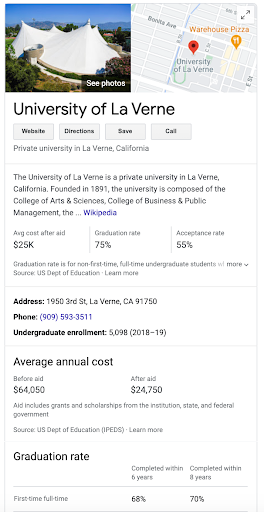
GMB property for University of La Verne’s main flagship campus
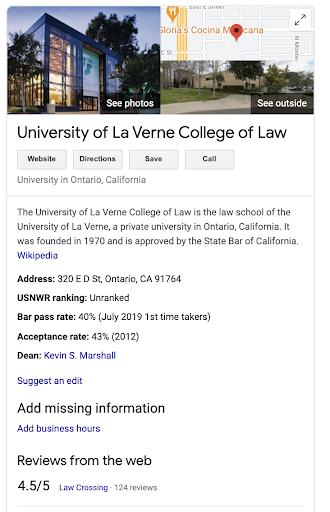
GMB property for University of La Verne’s College of Law
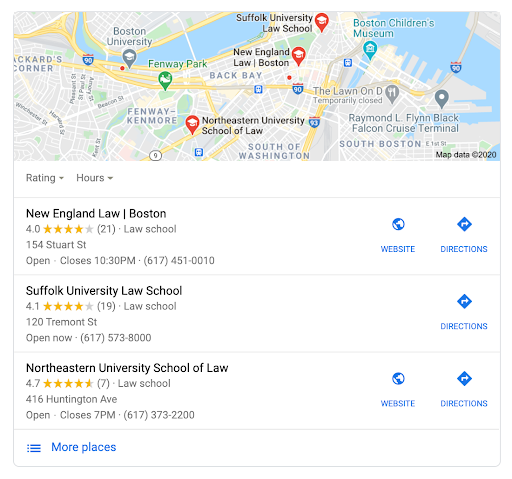
Local pack
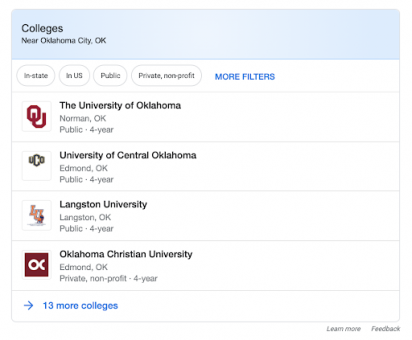
College pack
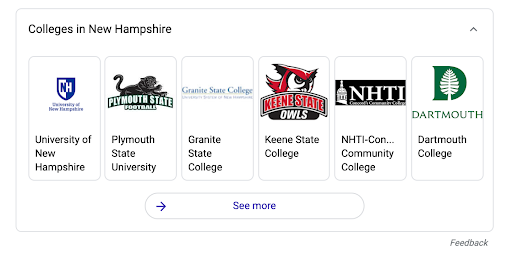
College cards
How to optimize your Google My Business property
If you haven’t done so already, the first thing you need to do is claim your GMB property and verify your ownership. From there, you can optimize your property on the back end by adding in categories and images and tweaking the name if need be. You should also add a description to the property and a UTM code to the website button. Learn how to understand the insights available in the back end of the GMB property here.
It’s important to note that Wikipedia content automatically gets pulled into the property, which must be changed in Wikipedia, not in the GMB property. Other data can also automatically pull in, such as IPEDS and College Scorecard, which cannot be edited in GMB. Social property names should match that of the GMB property in order for them to appear as well.
Google Knowledge Panel
Google also has what is known as the Knowledge Panel, which is similar to Google My Business but offers more features. For higher education, the GMB and KP overlap in many cases. Whereas Google My Business properties are for physical locations, Knowledge Panels are for brands.
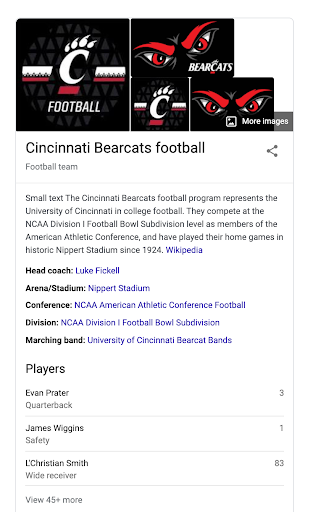
A Knowledge Panel for University of Cincinnati’s football team
If you see the “Claim this Knowledge Panel” button at the bottom of your institution’s GMB property, that means you also have the ability to control your school’s brand, to an extent, on Google. Whereas the GMB property is managed through business.google.com, the Knowledge Panel is managed through posts.google.com.

How to optimize your Knowledge Panel
If you haven’t done so already, the first thing you want to do is claim your Knowledge Panel. It’s important to note that not all GMB properties have a Knowledge Panel; this feature is mostly reserved for larger college or university-wide properties and not for individual colleges, schools, or departments. Once claimed, you can update your logo and in some cases manually connect social profiles. You can also tweak the name as needed.
Google Posts
For both Google My Business and Knowledge Panel, you have the ability to run posts, enabling you to feature upcoming events or deadlines right in your GMB property or Knowledge Panel for users to see in Google search results. This allows you to maximize this prime piece of SERP real estate by featuring important messaging. Posts can be used to advertise upcoming open houses, application deadlines, information sessions, and more.
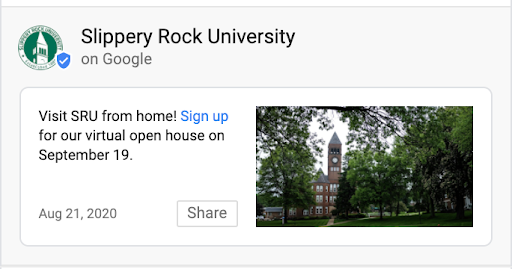
A Knowledge Panel post
How to optimize for Google Posts
You actually have full control over Google Posts within your GMB property and Knowledge Panel, meaning as soon as you post them, they will be live in the search results for users searching your brand name. It’s important to note that posts can only run for up to two weeks or, in the case of event posts, until the event has passed. You can run multiple posts at a time, though this will result in them appearing in a carousel, with the most recent post appearing first.
People Also Ask
The People Also Ask box displays questions related to a user’s initial query. This feature does not have a reserved spot and can appear anywhere in the search engine results page. It’s important to note that not every search warrants or triggers a People Also Ask box and that it most often appears for question-based searches. When users click the carrot or arrow to the right of each question, a search result appears that looks similar to a featured rich snippet. When you appear in this spot, you’re able to answer important questions that prospective students are asking about your school or a specific program—displaying you as the expert on the topic and building brand awareness and loyalty. The People Also Ask box also serves as a great keyword research tool, as it gives you ideas for long-tail questions you should optimize your site for and answer.

An example of a People Also Ask box
How to optimize for the People Also Ask box
In order to appear in the People Also Ask box, you must optimize your website for question-based searches. Think about your FAQ page—are the questions tagged as headers (H2)? Are the answers thorough? To further increase your chances, build an entire piece of content around a particular question you want to appear for, such as “What careers can I get with an MBA degree?”
Video
Video content has been on the rise for years now. Prospective students look for video content to get an authentic feel for your campus, culture, and program offerings. Therefore, appearing in the video carousel in the SERP is essential for meeting user needs. Since Google owns YouTube, the majority of video results that appear in Google are hosted on YouTube. Therefore, first and foremost, you want to ensure that your videos live on this platform. Learn more about how to optimize your videos for organic search here.
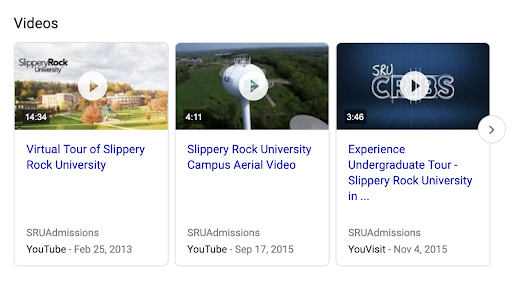
A carousel of YouTube videos in the Google SERP
How to optimize video content
The majority of videos that appear in Google search results are from YouTube. This is because Google owns YouTube and YouTube is the second-largest search engine after Google. Therefore, you first must ensure that your video content lives on this platform. Next, you must optimize both your YouTube account as well as individual videos. You can learn more about how to optimize your videos here. To increase your video visibility even further, you can utilize the video schema markup.
Discover
Discover is a Google feature that’s only available in its mobile app. It’s a “soft” news feed that serves up evergreen content to users based on their past search behavior. As such, users must be signed in to their Google account in order to get customized content in the Discover feed. This is a great space for schools to have their feature stories appear, building brand awareness and serving almost as a sort of organic Retargeting tactic for users who have interacted with your site before. YouTube videos can also appear in the Discover feed.
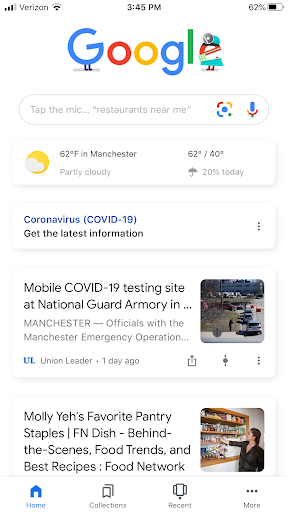
The Google Discover feed in the Google mobile app
How to optimize for the Discover feed
Consistently posting evergreen content is the best way to enhance your chances of showing up in Google’s Discover feed. It’s important to note that the content that appears here is not news content. Instead, it’s thought leadership content that isn’t time sensitive. Of course, you must also ensure that your content contains a title tag and meta description. The majority of Discover content has an accompanying image as well. Therefore, you should ensure that your content has a corresponding image that’s compressed so as not to affect page speed. The image file name should also contain keywords, as should the title text and alt text for the image.
News box
In Google, users can toggle to the “News” tab on the SERP to search for news-specific content. Some searches in the regular “All” search bar show News results as well. You have the best chance of a piece of content appearing in News if it’s a recently published article about recent events that contains a date stamp. Headlines and content should be written in the present tense for the best chances of appearing in Google News as well.
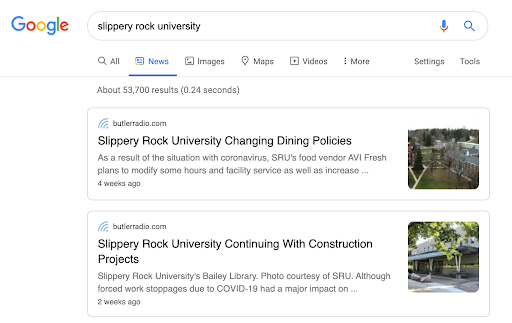
The News section of Google’s SERP
How to optimize for Google News
Articles that appear in Google’s News section are very time sensitive. In order to have your News content appear here, you should ensure that the content is written in the present tense, which signals to Google that it’s a news article. Furthermore, the article should have a timestamp as well as a byline. You should ensure that the title tag and meta description follow best practices and that the article contains an image that has also been optimized. Google’s News guidelines provide further guidance.
Events
Every college and university has a calendar of on-campus events. When these events are coded properly on your website, they can appear in the Events box in Google’s search results. It’s important to note that the majority of the events that appear here are in-person events that have physical locations. With that being said, Google has recently added an “Online events” filter to the Events box (as seen below), so we may expect to see more virtual events appearing here soon.
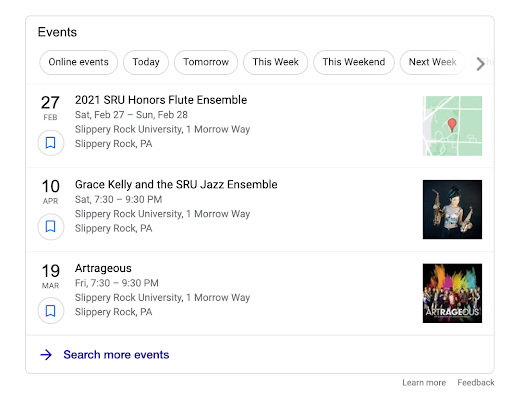
An Events box in the Google SERP
How to optimize for Events
In order for your event to appear in Google’s SERP, you must utilize schema markup. For some CMSs such as WordPress, there are easy plugins so you don’t have to hardcode the schema. It’s important that your events have clear names and dates and that the title tag and meta description of each event page clearly identifies the event name and date. The time and location of the event should also be specified, and there should be an image for each event as well.
Why colleges and universities should make special SERP features a part of their SEO strategies
As indicated in our recent study of COVID-19’s impact on the high school Class of 2021, 75% of students are using college websites for active information seeking—up from 66% in the past—with Google coming in at a very close second for the top college search resource. With this increased emphasis on the website and Google as college search tools, as well as the introduction of so many special SERP features over the past few years, it’s not just about appearing in organic search results but how you appear. Special SERP features allow you to take up more of the search result real estate and grab prospective students’ attention over the competition. With several features specific to higher education, such as the college pack and college cards, institutions need to be managing their brand’s appearance in search results.
Carnegie Dartlet’s team offers website audits, content optimization, workshops, and more to help you accelerate your SEO strategy. To learn more, reach out to us today.
